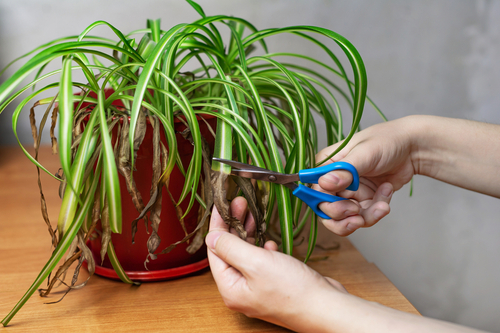Spider plants are a popular choice for indoor gardeners due to their hardiness and ease of care. However, even the most experienced plant owners can sometimes struggle to keep their spider plants healthy and thriving. One common issue that spider plant owners face is Spider plant leaves dying.
There are several signs that a spider plant is not doing well, including yellowing leaves, brown tips, and drooping foliage. These symptoms can be caused by a variety of factors, including overwatering, underwatering, poor soil quality, and pests.
It is important to identify the underlying cause of the problem in order to properly address it and revive the plant. In this article, we will explore the common causes of spider plant leaves dying and provide tips on how to revive a dying spider plant.
We will also discuss proper spider plant care, including soil quality, water quality, and identifying and addressing pests. By following these tips and tricks, you can ensure that your spider plant stays healthy and vibrant for years to come.
Key Takeaways on Spider Plant Leaves Dying
- Spider plants can experience several issues that cause leaves to die or turn yellow, including overwatering, underwatering, poor soil quality, and pests.
- It is important to identify the underlying cause of the problem in order to properly address it and revive the plant.
- Proper spider plant care, including soil quality, water quality, and identifying and addressing pests, can help prevent issues and keep your plant healthy.
Understanding Spider Plant Needs
Spider plants are easy to care for and can thrive in a variety of conditions. However, if their needs are not met, they can develop problems, such as dying leaves. Understanding the spider plant’s needs is crucial to keep it healthy and vibrant.
1. Light Requirements

Spider plants need bright, indirect light to grow well. They can tolerate low light, but it can slow down their growth and cause their leaves to lose their variegation. On the other hand, too much direct sunlight can scorch their leaves. Therefore, it’s best to place spider plants in a bright spot that receives indirect light for most of the day.
2. Watering Schedule
Overwatering is one of the most common reasons why spider plant leaves die. These plants prefer to be slightly dry between waterings, and their soil should never be soggy.
A good rule of thumb is to water them once a week during the growing season and reduce watering in the winter. It’s also essential to use well-draining soil and pots with drainage holes to prevent water from accumulating around the roots.
3. Ideal Soil Conditions
Spider plants thrive in well-draining soil that is rich in organic matter. A good soil mix for spider plants is a combination of peat moss, perlite, and vermiculite. The soil should be slightly acidic with a pH between 6.0 and 6.5. It’s also important to repot spider plants every one or two years to refresh their soil and prevent root-bound conditions.
4. Fertilizer Needs
Spider plants don’t require much fertilizer, but they benefit from occasional feeding during the growing season. A balanced, water-soluble fertilizer with an NPK ratio of 10-10-10 or 20-20-20 is suitable for spider plants.
It’s best to dilute the fertilizer to half strength and apply it every four to six weeks. Overfertilization can cause burning of the roots and leaves, so it’s important to follow the instructions on the label.
Common Issues and Their Signs
Spider plants are generally easy to care for, but sometimes they can experience issues that cause their leaves to die. Here are some common issues and their signs that you should be aware of:
1. Overwatering and Underwatering
Overwatering and underwatering are two of the most common issues that spider plants can face. Overwatering can cause the roots to rot, while underwatering can cause the leaves to wilt and turn brown.
Signs of overwatering include yellowing leaves, mushy stems, and a foul odor coming from the soil. Signs of underwatering include dry soil, wilted leaves, and brown tips.
To avoid overwatering, make sure to let the soil dry out completely before watering again. To avoid underwatering, water the plant when the soil is dry to the touch, but not bone dry.
2. Nutrient Deficiency and Overfertilizing

Spider plants need nutrients to thrive, but too much or too little can cause issues. Signs of nutrient deficiency include yellowing leaves, stunted growth, and brown tips. Signs of overfertilizing include burned roots, brown tips, and wilting leaves.
To avoid nutrient deficiency, make sure to fertilize the plant regularly with a balanced fertilizer. To avoid overfertilizing, follow the instructions on the fertilizer package and do not fertilize more frequently than recommended.
3. Heat and Light Exposure
Spider plants prefer bright, indirect light and temperatures between 60-75°F. Too much direct sunlight can cause the leaves to dry out and turn brown, while too little light can cause the leaves to yellow and drop. High temperatures can also cause the leaves to wilt and turn brown.
To avoid heat and light exposure issues, place the plant in a bright, but indirect location and avoid placing it near windows that receive direct sunlight. Keep the plant in a room with a temperature between 60-75°F.
4. Humidity Issues
Spider plants prefer humidity levels between 40-60%. Low humidity can cause the leaves to dry out and turn brown, while too much moisture can cause root rot and fungal growth.
To avoid humidity issues, mist the leaves regularly or place a humidifier near the plant. Avoid overwatering the plant and make sure the soil is well-draining.
Identifying and Addressing Pests
Spider plants are generally hardy and resistant to pests, but they can still fall victim to a variety of insects. Identifying the pest and taking appropriate action is important to prevent further damage to the plant.
1. Common Pests
The most common pests that affect spider plants are spider mites, mealybugs, and whiteflies. Spider mites are tiny, eight-legged creatures that can be identified by the fine webbing they leave behind.
Mealybugs are small, white, cottony insects that are often found in the crevices of the plant. Whiteflies are small, winged insects that feed on the sap of the plant and leave behind a sticky residue.
2. Addressing Insect Infestations
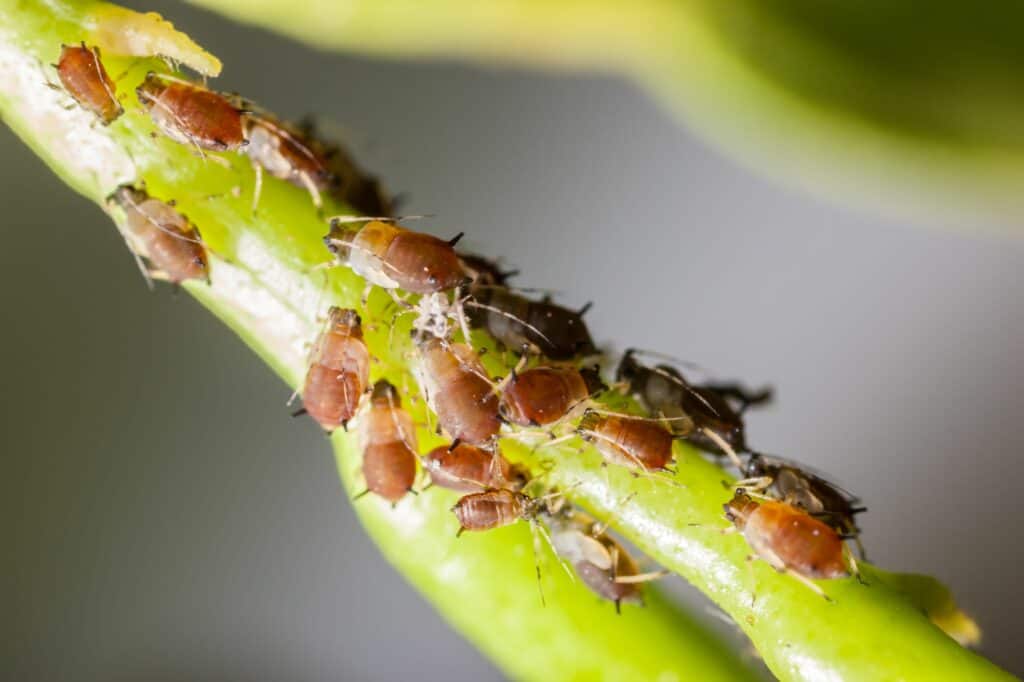
If a spider plant is infested with insects, it is important to take action quickly to prevent the pests from spreading to other plants. The first step is to remove any affected leaves or stems and dispose of them in the trash. Then, the plant should be treated with an insecticide.
There are many different types of insecticides available, and it is important to choose one that is safe for use on spider plants. Some common insecticides include neem oil, insecticidal soap, and pyrethrin. These products can be found at most garden centers or online.
When using an insecticide, it is important to follow the manufacturer’s instructions carefully. Some insecticides may need to be applied multiple times to be effective, and it is important to wait the recommended amount of time between applications. It is also important to avoid over-spraying the plant, as this can damage the leaves and stems.
In addition to using an insecticide, it is important to keep the plant healthy and well-maintained. Regular watering and fertilization can help to strengthen the plant and make it more resistant to pests. It is also important to keep the plant in a location with good air circulation, as this can help to prevent insect infestations.
Reviving a Dying Spider Plant
Spider plants are popular houseplants due to their ease of care and air-purifying qualities. However, they can still experience issues with dying leaves, which can be caused by over or underwatering, nutrient deficiencies, and heat and light damage.
If you notice your spider plant leaves turning brown, drooping, wilting, or turning yellow, it may be time to take action to revive your plant.
Reviving Overwatered Plants
Overwatering is a common cause of spider plant decline and can lead to root rot, which can be fatal. To revive an overwatered spider plant, follow these steps:
- Remove the plant from its pot and examine the roots. If they are mushy and brown, trim them back to healthy tissue.
- Repot the plant in fresh, well-draining soil, making sure not to overwater it in the future.
- Allow the plant to dry out between waterings and make sure the pot has drainage holes to prevent water from accumulating in the soil.
Reviving Underwatered Plants
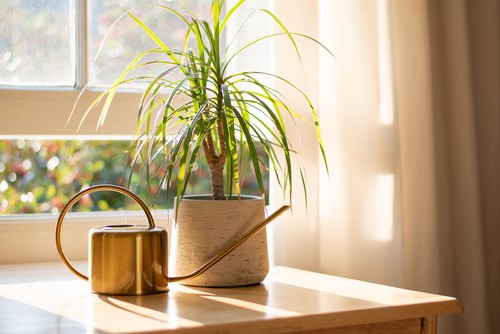
Underwatering can also cause spider plants to wilt and decline. To revive an underwatered spider plant, follow these steps:
- Water the plant thoroughly, making sure the soil is moist but not soggy.
- Mist the leaves with water to increase humidity levels.
- Place the plant in a shaded area to prevent further stress.
Addressing Nutrient Deficiencies
Spider plants require regular fertilization to maintain their health and vigor. If your spider plant is showing signs of nutrient deficiencies, such as yellow leaves, it may be time to fertilize. Here are some tips:
- Use a balanced fertilizer specifically formulated for houseplants.
- Follow the instructions on the fertilizer package and apply it to the soil once a month during the growing season.
- Avoid overfertilizing, as this can lead to salt buildup in the soil and damage the plant.
Fixing Heat and Light Damage
Spider plants prefer bright, indirect light and temperatures between 60-75°F. If your plant is exposed to too much direct sunlight or extreme temperatures, it may show signs of damage, such as brown or wilted leaves. To fix heat and light damage, follow these steps:
- Move the plant to a shaded area or away from direct sunlight.
- Adjust the temperature to within the recommended range.
- Trim back any damaged leaves to encourage new growth.
Repotting and Soil Quality
When spider plant leaves start to die, it may be a sign that the plant needs to be repotted. Repotting can help provide the plant with more space to grow and access to fresh soil, which can improve its overall health. Here are some tips for repotting and improving soil quality:
When to Repot
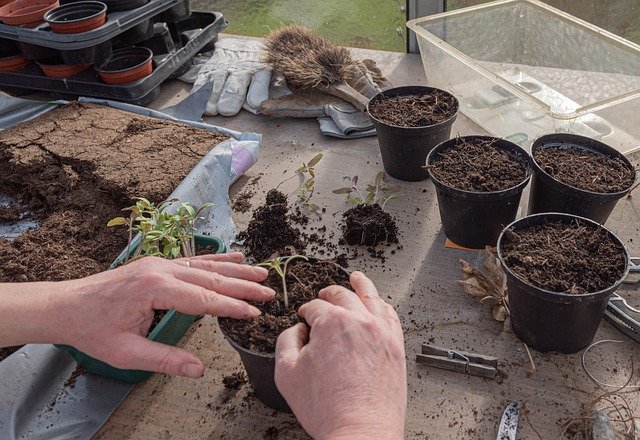
Spider plants should be repotted every one to two years to prevent them from becoming root-bound. Signs that a spider plant needs to be repotted include roots growing out of the bottom of the pot, soil drying out quickly, and stunted growth.
The best time to repot a spider plant is in the spring or early summer when it is actively growing. Repotting during this time will allow the plant to recover quickly from any stress caused by the repotting process.
Choosing the Right Pot and Drainage
When choosing a new pot for a spider plant, it is important to select one that is only a few inches larger than the current pot. A pot that is too large can cause the soil to stay wet for too long, which can lead to root rot.
It is also important to choose a pot with drainage holes to allow excess water to drain out of the soil. Without proper drainage, the soil can become waterlogged and lead to root rot.
Improving Soil Quality
To improve soil quality, it is recommended to use an indoor plant soil mix that is well-draining and rich in nutrients. The soil mix should be fresh and free of pests and diseases.
Before repotting, it is also a good idea to remove any dead or yellowing leaves and inspect the roots for any signs of damage or disease. If any roots are damaged, they should be removed before repotting.
Water Quality and Its Effects
Spider plants are sensitive to the quality of water they receive. The type of water used for watering can have a significant impact on the health of the plant. In this section, we will discuss the effects of tap water, the benefits of distilled and rainwater, and how to address salt buildup.
Effects of Tap Water
Tap water is the most commonly used water source for watering spider plants. However, tap water can contain minerals and chemicals such as chlorine and fluoride that can harm the plant. The buildup of salts in the soil can also occur with regular use of tap water, leading to leaf discoloration and wilting.
Benefits of Distilled and Rainwater
Distilled and rainwater are two alternative water sources that can benefit spider plants. Distilled water is free from minerals and chemicals, making it an ideal choice for watering spider plants. Rainwater is also an excellent option as it is naturally soft and contains essential nutrients that can benefit the plant.
Using a saucer of water is another way to provide spider plants with high-quality water. Simply fill a saucer with distilled or rainwater and place the plant pot on top of it. This will allow the plant to absorb water as needed, ensuring that it receives the right amount of moisture without overwatering.
Addressing Salt Buildup
Salt buildup can occur when tap water is used regularly for watering spider plants. This can lead to leaf discoloration and wilting, as well as stunted growth. To address salt buildup, it is recommended to flush the soil with distilled or rainwater every few months. This can be done by watering the plant with distilled or rainwater until it runs out of the drainage holes at the bottom of the pot.
Proper Spider Plant Care Routine
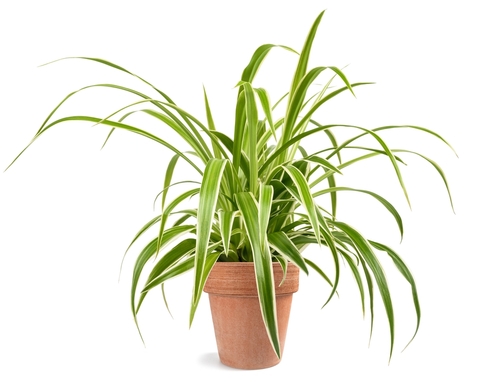
Creating a Care Routine
Creating a proper care routine is crucial for the health of a spider plant. The routine should include regular watering, pruning, and maintenance. Overwatering or underwatering can lead to the death of the plant.
A spider plant should be watered when the top inch of soil is dry to the touch. It is essential to avoid letting the soil become too dry or too wet.
Choosing the Right Location
Choosing the right location is also important for the health of a spider plant. Spider plants thrive in bright, indirect light. Direct sunlight can scorch the leaves, while too little light can cause the plant to grow slowly or not at all. It is best to place the spider plant near a window that receives bright, indirect light.
Pruning and Maintenance
Pruning and maintenance are essential for the proper care of a spider plant. Dead or yellow leaves should be removed to prevent the spread of disease.
Spider plants can also benefit from periodic grooming to remove dust and debris from the leaves. It is important to avoid over-fertilizing the plant, as this can lead to yellowing of the leaves.
Frequently Asked Questions
How do you revive a dying spider plant?
Reviving a dying spider plant requires identifying the cause of the problem and taking corrective measures. Common causes of spider plant death include overwatering, underwatering, pests, and diseases.
To revive a dying spider plant, start by watering it properly and ensuring that the soil is well-draining. Remove any dead or yellow leaves and treat any pests or diseases. You can also consider repotting the plant in fresh soil and adjusting the lighting conditions.
Should I cut dead leaves off spider plant?
Yes, you should cut off dead leaves from a spider plant. Dead leaves can attract pests and diseases, and they can also drain the plant’s resources. Use a pair of clean, sharp scissors to cut off any dead or yellow leaves as close to the base as possible. Be careful not to damage the healthy leaves or the stem.
Why are my spider plant leaves turning brown and dying?
Spider plant leaves can turn brown and die for several reasons, including overwatering, underwatering, low humidity, pests, and diseases. If the leaves are turning brown at the tips, it may be a sign of overwatering or low humidity.
If the leaves are turning brown and crispy, it may be a sign of underwatering. Check the soil moisture level and adjust your watering routine accordingly. Treat any pests or diseases promptly.
Why is my spider plant drooping?
A drooping spider plant can be a sign of underwatering, overwatering, or low humidity. Check the soil moisture level and adjust your watering routine accordingly. If the soil is too dry, water the plant thoroughly and ensure that the soil is well-draining.
If the soil is too wet, allow it to dry out before watering again. Increase the humidity level by misting the leaves or placing a tray of water near the plant.
Why is my spider plant pale and limp?
A pale and limp spider plant can be a sign of overwatering, underwatering, or low light. Check the soil moisture level and adjust your watering routine accordingly.
Ensure that the plant is getting enough light and move it to a brighter location if necessary. If the plant is in a low light area, consider supplementing with artificial light.
How to save spider plant from root rot?
Root rot is a serious condition that can be fatal to spider plants. To save a spider plant from root rot, start by removing the plant from the soil and inspecting the roots.
Cut off any mushy or discolored roots and discard them. Repot the plant in fresh, well-draining soil and water it sparingly until it recovers. Avoid overwatering and ensure that the soil is well-draining.

Hey, I’m Lisa and I’ve been an avid gardener for over 30 years. I love writing, talking and living in the garden! Feel free to connect with me on my socials below

